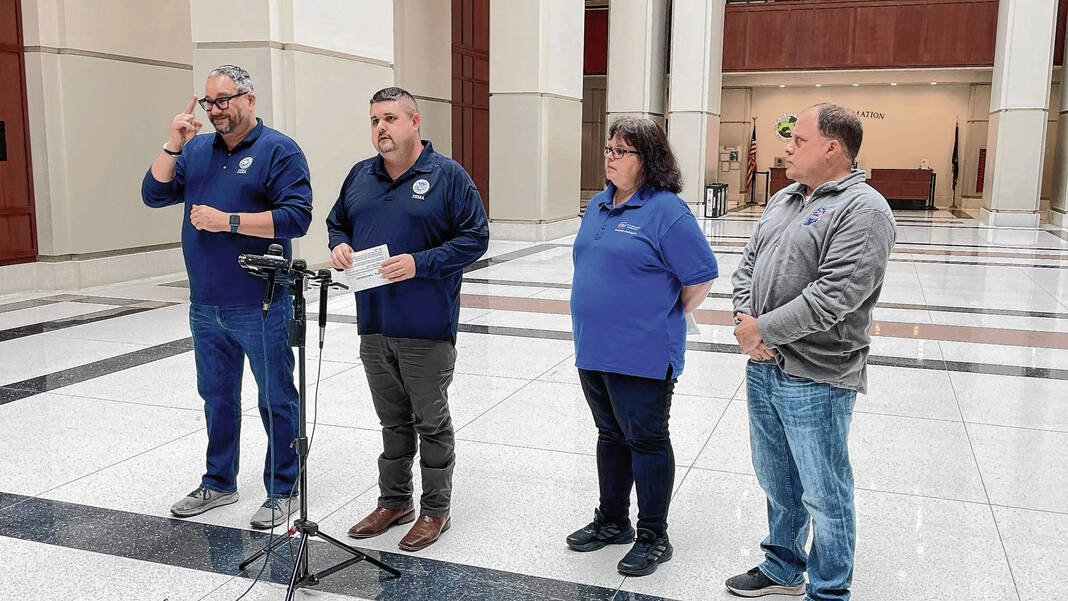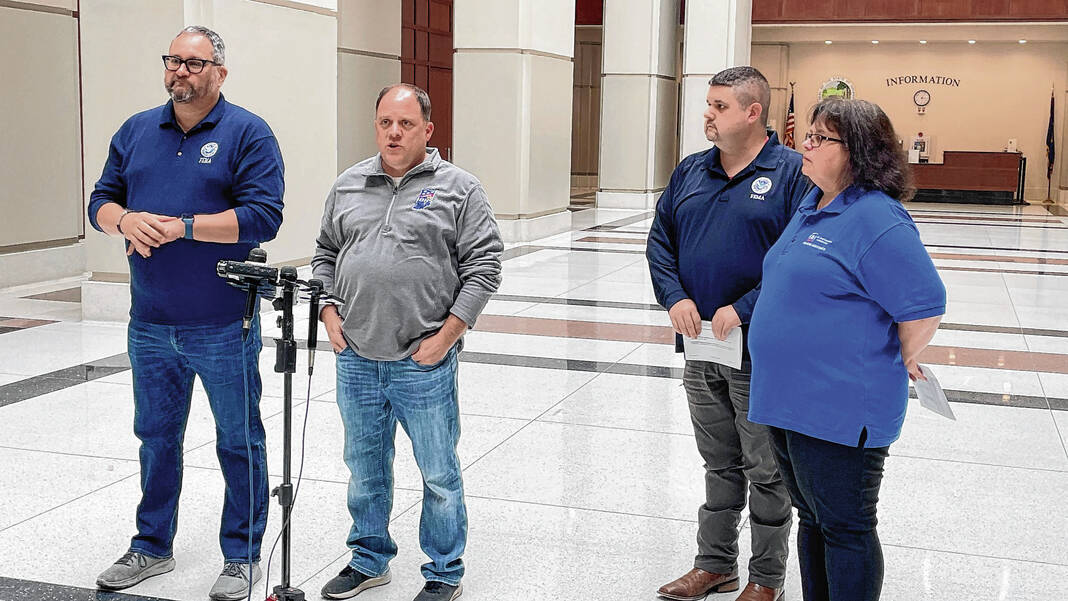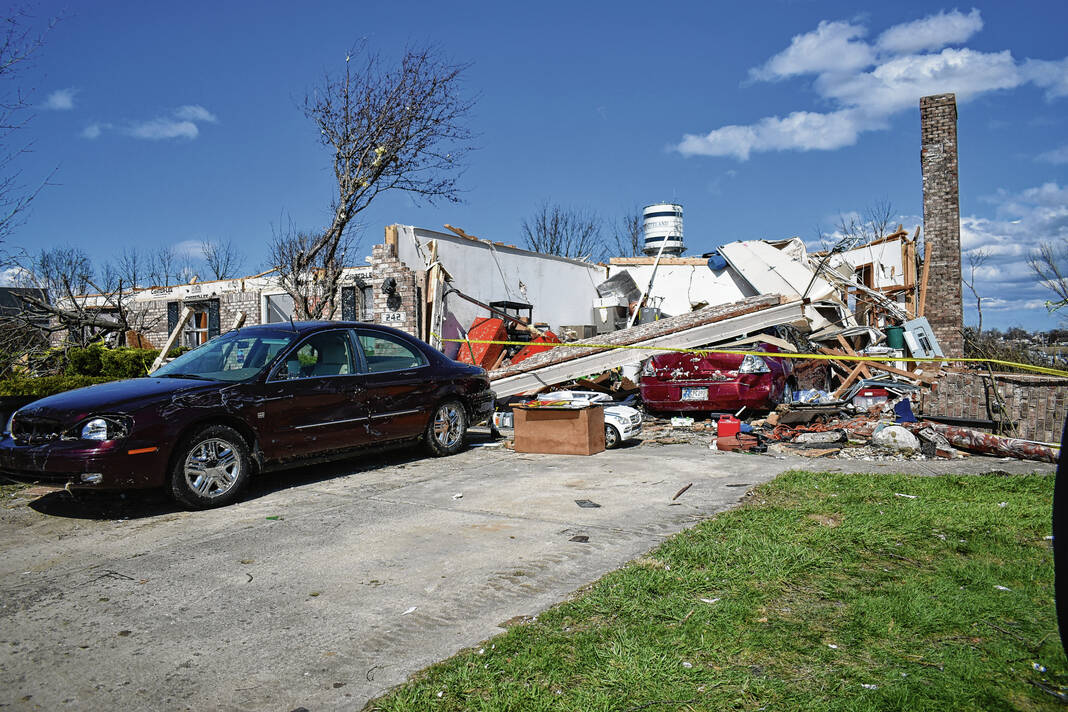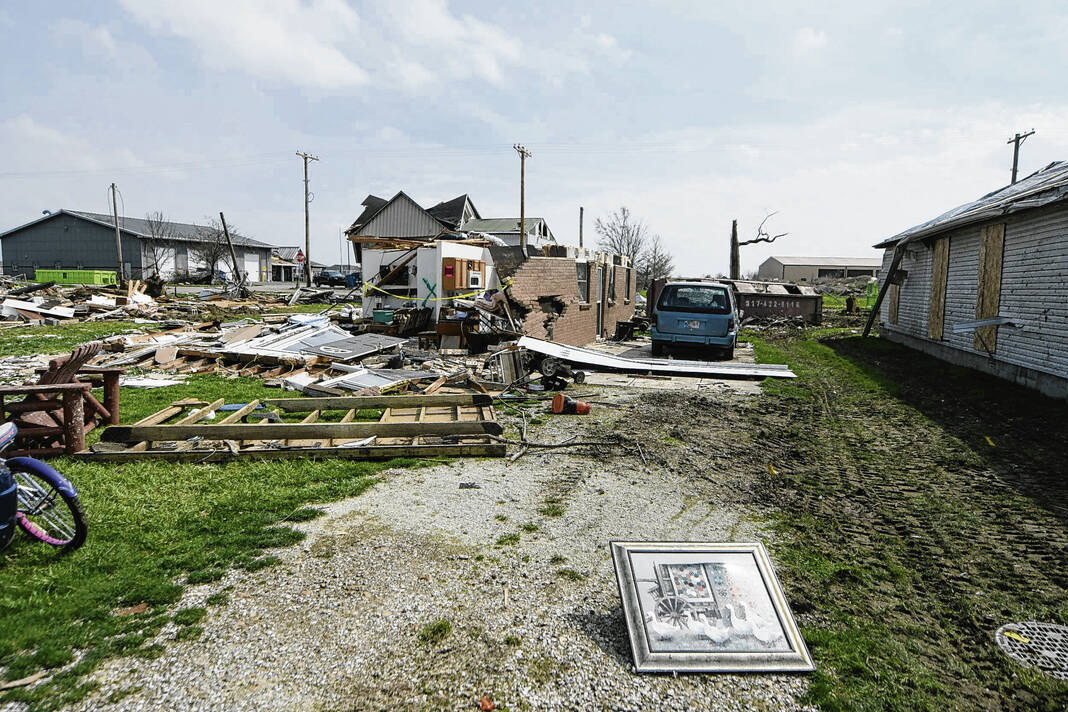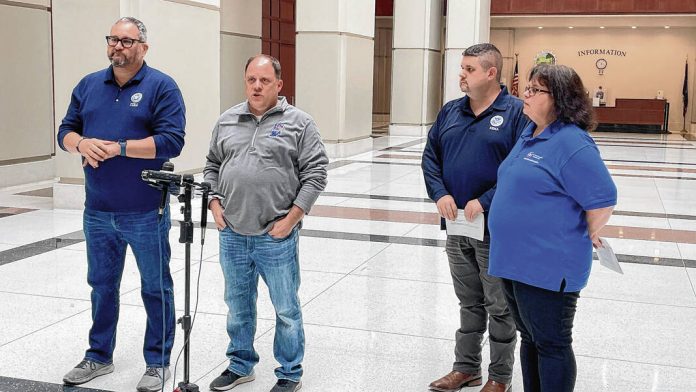
IDHS Director of Public Affairs David Hosick, second from left, speaks to the media during a briefing on disaster response and recovery efforts on Friday in Indianapolis. Federal aid is available for residents and businesses affected by severe storms and tornadoes earlier this month.
Noah Crenshaw | Daily Journal
INDIANAPOLIS — Days after arriving in Indiana to assist Hoosiers affected by severe weather and tornadoes, federal officials have already received more than 500 aid applications, they said Friday.
Earlier this month. President Joe Biden approved a request for a major disaster declaration for Indiana, making federal disaster assistance available to supplement state and local recovery efforts following severe storms on March 31 and April 1. Severe storms caused a total of 23 tornadoes across the state, damaging more than 1,000 structures, injuring 34 and killing five.
In Johnson County, two tornadoes touched down on March 31: an EF-0 near Bargersville that downed power lines and damaged buildings and an EF-3 that caused significant damage in Whiteland, damaging 179 homes — including destroying 16. Straight-line winds also caused damage across the county.
During a press conference at Indiana Government Center South in Indianapolis on Friday, officials from the Federal Emergency Management Agency, Small Business Administration and the Indiana Department of Homeland Security provided updates on disaster relief efforts and assistance. FEMA is operating in a supporting role, with the state managing and local officials executing response efforts.
Since a federal disaster was declared earlier this month, federal funding has been made available to affected individuals not only in Johnson County, but also Allen, Benton, Clinton, Grant, Howard, Lake, Monroe, Morgan, Owen, Sullivan and White counties. Assistance available includes grants for temporary housing and home repairs, low-cost loans to cover uninsured property losses and other programs to help individuals and business owners recover from the effects of the disaster, according to FEMA.
Since Monday, FEMA’s Disaster Survivor Assistance Teams have been going door to door in the 12 counties declared as federal disaster areas to make sure residents are getting registered for federal aid. The teams have already met with around 250 residents so far, said Craig Browning, an external affairs officer for FEMA.
“These folks can answer questions that you have regarding your application,” Browning said. “They can get you registered for federal assistance and just help guide you along the way.”
The teams will continue to be on the ground until officials have reached every survivor, he said.
“We want to ensure that survivors here in Indiana are getting the support that they need,” Browning said.
For residents who already have left the affected areas, FEMA officials are working with state and local officials to get hold of them and to make sure they apply for federal aid. The agency has already received more than 500 aid applications statewide, and more than $482,000 has been allocated to survivors and applicants so far, he said.
Federal officials will also be opening Disaster Recovery Centers in affected areas in the next week or so. The centers are designed to help residents with submitting documents in person to speed the application process along, Browning said.
Some of the centers will be fixed at one location, while others will be roaming from community to community. One of the fixed centers will be in Whiteland, though an official opening date and location is still being determined, officials said.
“We want to reach people where they are, and so we want to be able to make sure that nobody is left out that needs the assistance,” Browning said.
The Small Business Administrating will also be present at the recovery centers, and SBA officials encourage not only business owners to come in and apply for aid, but also homeowners and renters, said Yvette Jeffrey, a public affairs specialist for SBA.
“We will have staff there with FEMA to provide assistance with documentation, filling out the application,” Jeffrey said. “We’re here not only for businesses.”
The SBA has also established a Business Recovery Center at Grace Assembly of God Church, 6822 N. U.S. Highway 31, Whiteland. The center will be open Monday to Friday from 9 a.m. to 5 p.m., and will be open from 10 a.m. to 2 p.m. Saturdays starting April 28, she said.
Officials once again stressed the need for those who’ve already applied for state aid to apply for federal aid. Those who called the state’s 211 line earlier this month to register for aid will have to re-register with FEMA, a separate entity, said David Hosick, director of public affairs for IDHS.
“Even if you’ve registered with 211, please go through the process of the 800 number, the website or the FEMA app to get that registration completed and start the process toward recovery,” Hosick said.
Those who have applied for federal aid already, should also expect to see federal inspectors come to verify the damage. The inspectors will have federal identification, Browning said.
Even though inspectors will be visiting applicants, it doesn’t mean residents should stop the clean-up process. Survivors also don’t have to wait for an inspector to come to begin documenting the damage, cleanup efforts and repairs, he said.
“We want you to start your recovery. We want you to start picking up those pieces,” he said. “Just document, take pictures (and) if you go and purchase something to help with that cleanup, save those receipts.”
So far officials have not heard of any scams or widespread disaster fraud, Jeffrey said. The SBA will be putting out messages about fraud prevention in the future, she said.
But the easiest way to check if a person is who they say there is to check their federal ID.
“We will have federal IDs so you can always verify that we are employed by FEMA and SBA,” Jeffrey said.
HOW TO GET AID
Residents who sustained losses because of severe weather late last month can apply for federal assistance in three different ways. The deadline to apply for FEMA assistance is June 14:
- Online at DisasterAssistance.gov
- By phone at 800-621-3362. TTY users can call 800-462-7585; 711 or Video Relay Service users can call 800-621-3362.
- Downloading and using the FEMA App
The FEMA helpline will be available from 7 a.m. to 1 a.m. daily.
To apply for assistance, residents need the following information:
- Address with zip code
- Condition of damaged home
- A general list of damage and losses
- Insurance information, if available
- Social Security number
- Banking information, if they choose direct deposit for funds
- Phone number where they can be reached
- Address where they can get mail or an email address for electronic updates
Source: Federal Emergency Management Agency


